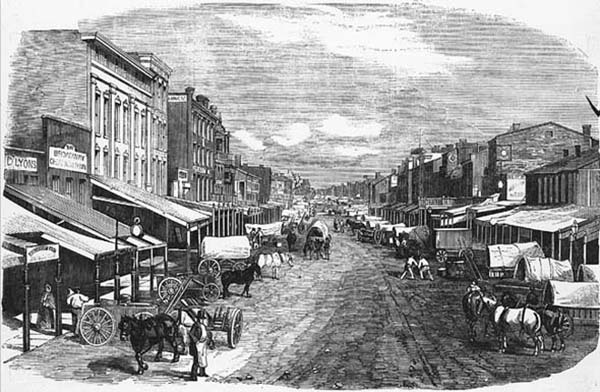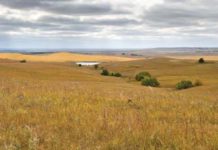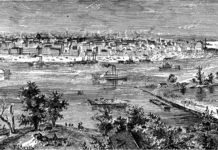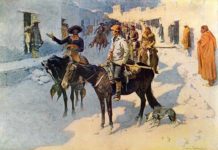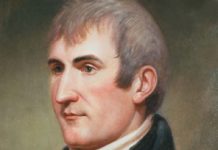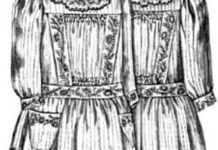“Damn Manuel and triply damn Mr. B,” Manuel Lisa’s partner Francois Benoit, wrote Meriwether Lewis to William Clark after the Spaniard had fouled up the supplies Lewis and Clark had purchased from Lisa for their venture west. Another of Lisa’s enemies, which included nearly everyone he knew, left a negative description when he wrote, “Rascality set on every feature of his dark-complexioned Mexican face.”
Lisa came to Saint Louis from New Orleans in 1798. Then Saint Louis and the Missouri River Valley were under Spanish rule and Lisa was Spanish, unlike Saint Louis’ founding family, the Chouteaus, who were French. Having no qualms about exploiting this advantage, Lisa obtained the rights to trade with the Osage Tribe, a trade privilege the Chouteaus had held for nearly a decade. In Lisa’s petition for this privilege he proposed to make a $1,000 gift to the royal Spanish treasury. But the Chouteaus did not let Lisa steal this lucrative and monopolized business they’d held while exploiting the Osage by selling them whiskey to secure better trading deals.
Lisa’s official agreement gave him the sole right to deal with the Osages of the Missouri. He may not have considered that, at the time, the Osage dwelt only in the Missouri Valley. But the Chouteaus considered it and, somehow, convinced half of the Osage to relocate to the valley of the Arkansas River. There, the Chouteaus legally continued their trade with them.
But Lisa accumulated wealth by dealing in real estate and buying and selling slaves. He also thought it would be profitable to open trade between Saint Louis and Santa Fe, some 900 miles distant. When he presented this idea to James Wilkinson, the new governor of Louisiana Territory, the man vetoed it, saying “no good can be derived to the United States from such a project.” Wilkinson’s felt, so he said, that success of the scheme would “depend entirely upon the Spaniards,” of which Lisa was one, and that the Spaniards would not permit such an intrusion, unless to serve their political and personal interest. He was right, as Lieutenant Zebulon Pike discovered when he landed in a Spanish jail. After Wilkinson turned down Lisa’s proposal he sent Pike on just such a journey. Lisa retaliated by detaining the expedition when he had Pike’s interpreter arrested for debt.
Until now the fur industry had operated by trading merchandise to the Indians for pelts but Lisa changed much of this. After purchasing two keelboats and hiring fifty men, he started up the river. He planned to use white men to trap the beaver, thus omitting a considerable portion of the cost of the Indian trade. Whether it was because he was not liked or his fellow merchants thought his scheme foolhardy, no one would help back this venture. But that didn’t stop Lisa. He was up the Missouri River, right in the wake of John Jacob Astor’s fur brigade that was heading west, some nineteen days ahead of Lisa. The Spaniard planned to use Astor’s group as protection from the Sioux and other menacing native tribes.
Lisa was also determined to over-take Astor’s group who bent their backs in an effort to stop Lisa’s party from catching them. The outcome of this Lisa-Astor race up the Missouri River was never equaled again. Lisa’s party caught the Astor’s and in only sixty-one days made the 1200 miles up-stream. They had run-ins with the Arikara and the Mandans, as well as the Assiniboins in November of 1806, before they ascended the Yellowstone to the entrance of the Bighorn River to the land of the friendly Crow.
His plan to use white men as trappers was far more profitable than Lisa had dreamed. In August of 1808 he was back in Saint Louis with a fortune in pelts. Where he had previously made enemies and was denied any monetary backing, he was now received as a conquering hero. His old enemies and rivals clamored to finance his next trip. Even Pierre and Auguste Chouteau lent their support as did Benjamin Wilkinson, the brother of the Governor who had vetoed Lisa’s Santa Fe venture.
The following spring a fleet of thirteen keelboats and barges, with about three hundred men of Lisa’s Missouri Fur Company, headed up-stream towards the mountains where a wealth of beaver could be transformed into gold.


